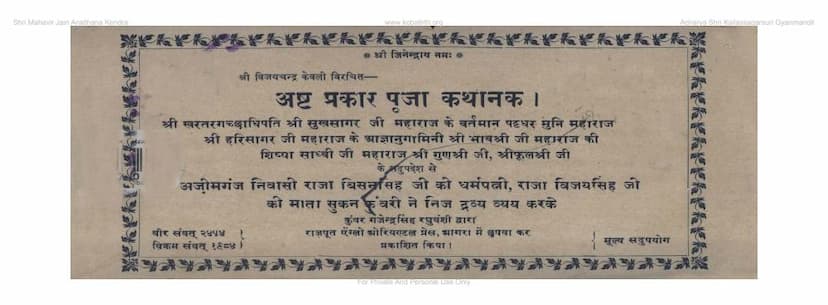Ashtaprakari Pooja Kathanak
Added to library: September 1, 2025

Summary
This document is a summary of the Jain text "Ashtaprakari Pooja Kathanak" (Stories of the Eight Types of Worship), authored by Vijaychandra Kevali. The book was published by Gajendrasinh Raghuvanshi.
The text details the significance and practice of the eight types of ritualistic worship in Jainism:
-
Gandh/Vāskṣepa Pooja (Fragrant Powder/Aromatic Paste Worship): This worship involves offering fragrant powders and pastes. The text narrates the story of King Jayashur and Queen Sukhmati, who through their devotion and the proper use of sandalwood paste, attained liberation.
-
Dhūpa Pooja (Incense Worship): This chapter focuses on the merits of offering incense. It tells the story of Prince Vinaydhar, who, through his sincere offering of incense, overcame obstacles, revealed his true lineage, and attained immense prosperity and eventually liberation.
-
Akṣata Pooja (Unbroken Rice Worship): This section highlights the benefits of worshipping with unbroken rice grains. The story of the parrot couple and their devotion through rice worship illustrates how such acts lead to divine rewards and ultimately, liberation.
-
Puṣpa Pooja (Flower Worship): The importance of worshipping with flowers is explained. The story of Jinmati and Lilavati, two friends, demonstrates how sincere flower worship, even in the face of jealousy, leads to divine favor, prosperity, and spiritual advancement.
-
Dīpa Pooja (Lamp Worship): This part explains the significance of offering lamps. The story of Jinmati and Dhanashri, two friends, shows how dedicating lamps to the Tirthankaras brings about divine blessings, wealth, and ultimately, liberation.
-
Naivedya Pooja (Food Offering Worship): This section focuses on the virtue of offering food to the Tirthankaras. The story of a farmer (Hali) who, through his simple yet sincere offering of food, received divine blessings, wealth, and eventually attained liberation.
-
Phala Pooja (Fruit Worship): This chapter emphasizes the merit of offering fruits. The story of a poor woman (Durgata) and a parrot couple, who through their offerings of fruits, attained immense prosperity and spiritual progress.
-
Jala Pooja (Water Worship): This section details the importance of water worship. The story of Somashri, a Brahmin's daughter-in-law, who, despite facing hardship and opposition, offered water to the Lord and attained great merit and liberation.
The book, originally in Gujarati, was translated into Hindi to make its teachings accessible to a wider audience. It emphasizes that both ritualistic (dravya) and spiritual (bhāva) worship are important in Jainism, butdravya worship serves as a foundation for bhāva worship. The narratives are designed to illustrate the spiritual and material benefits of each type of worship, encouraging devotees to follow the path of righteousness and devotion. The text also includes biographical details of the spiritual mentors who guided the efforts to publish this work.